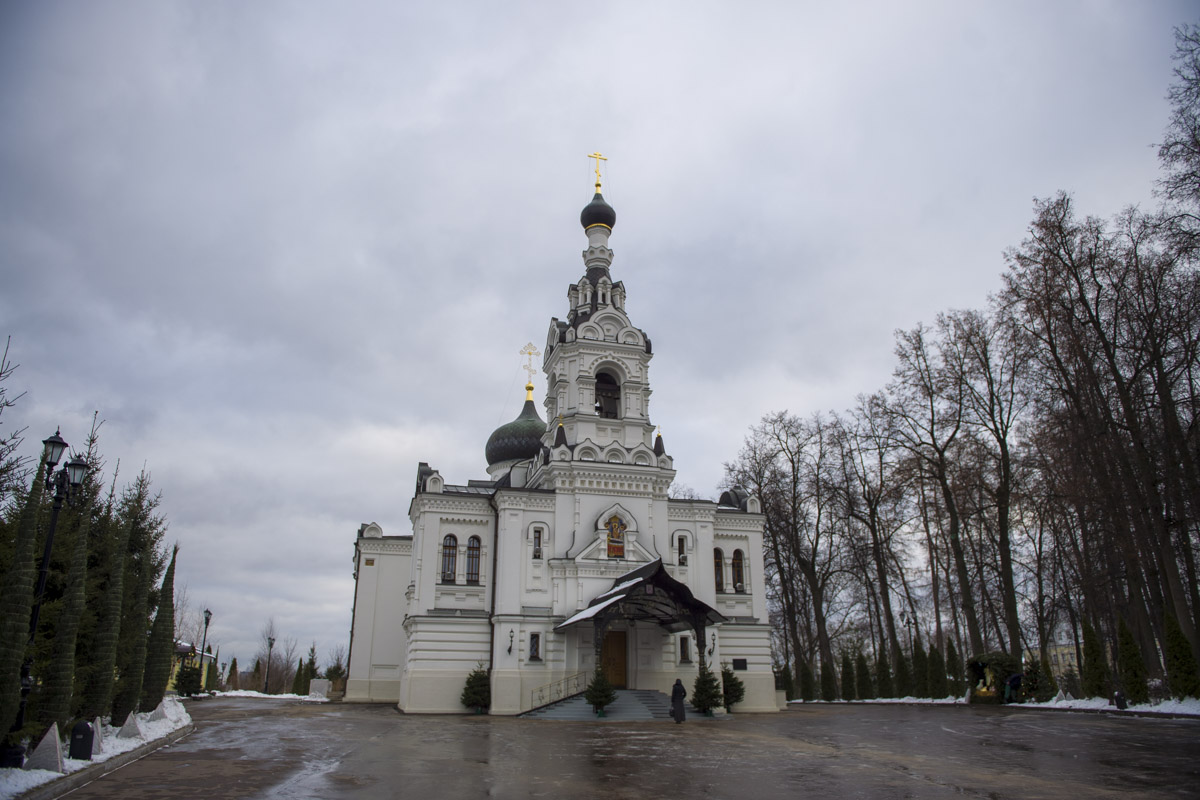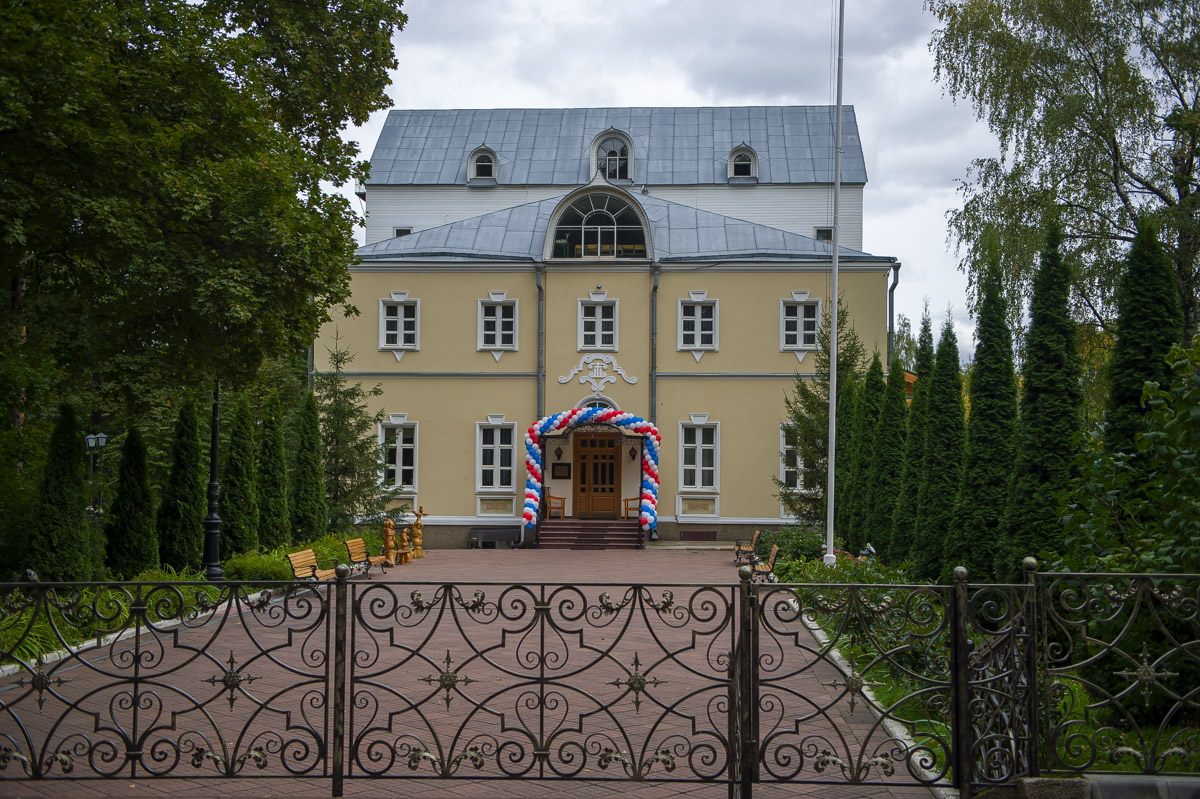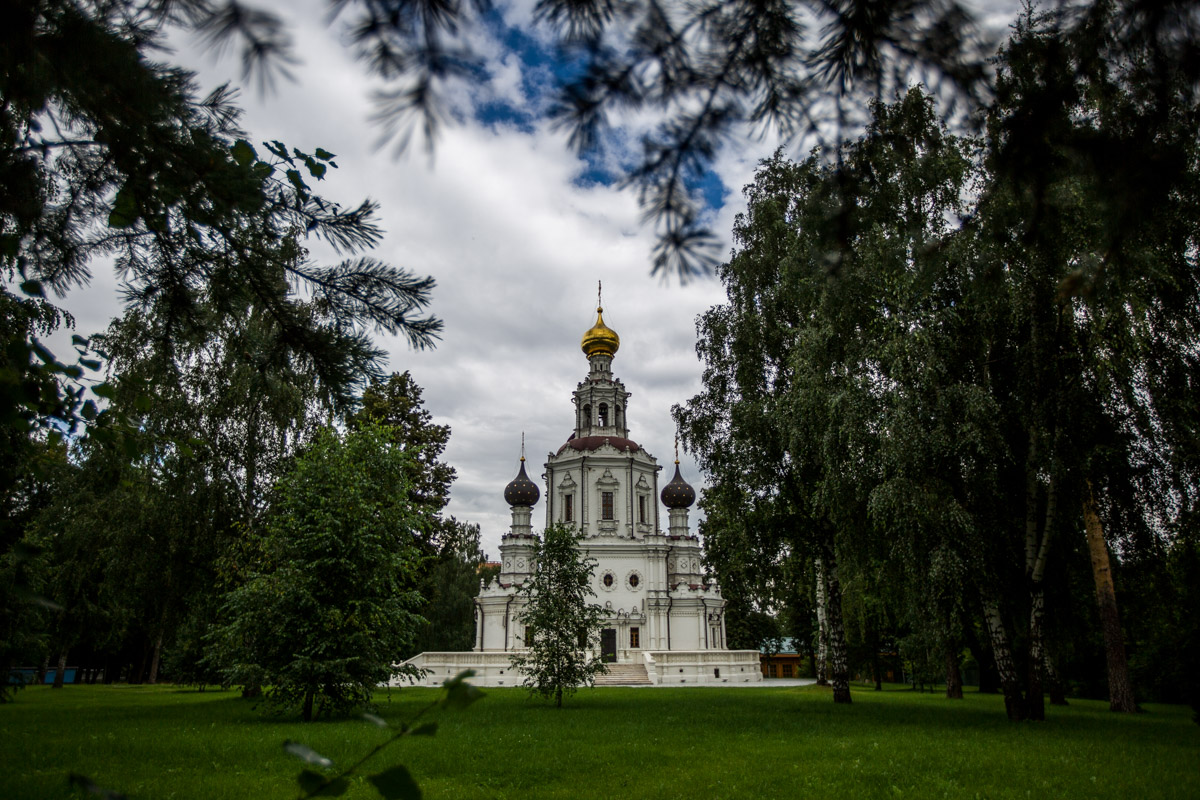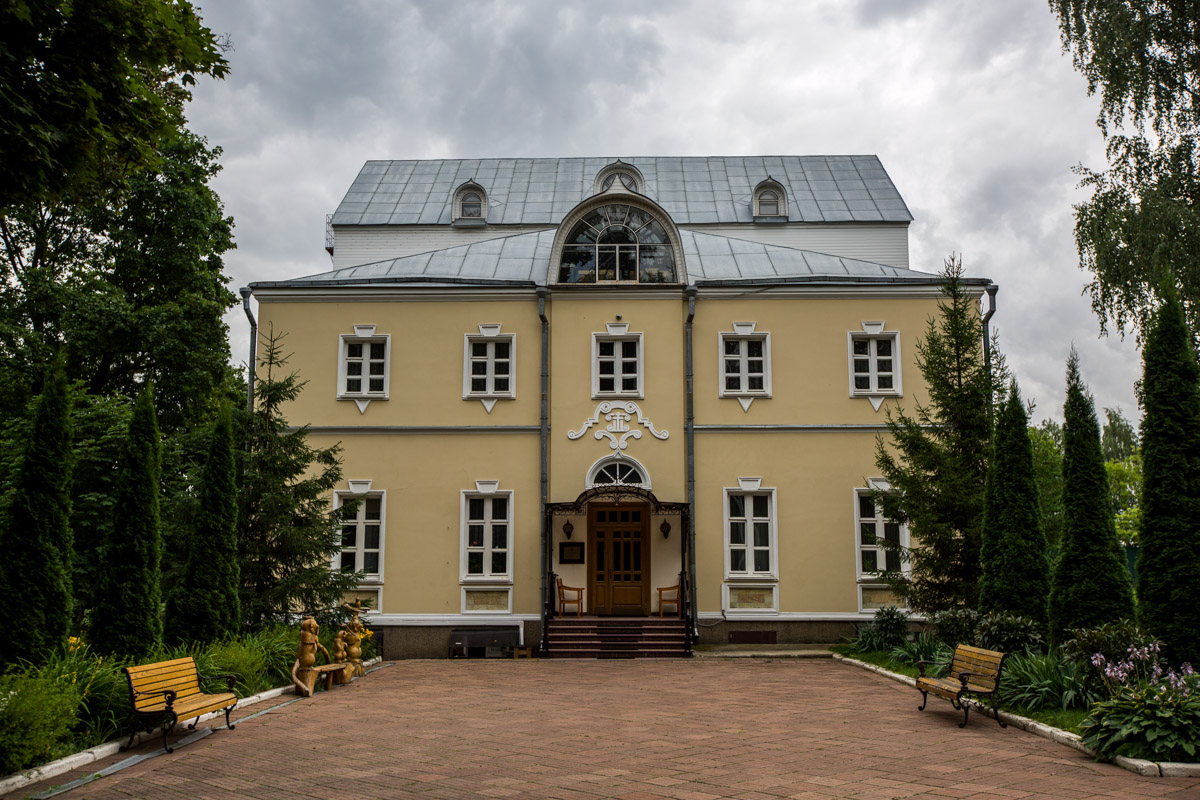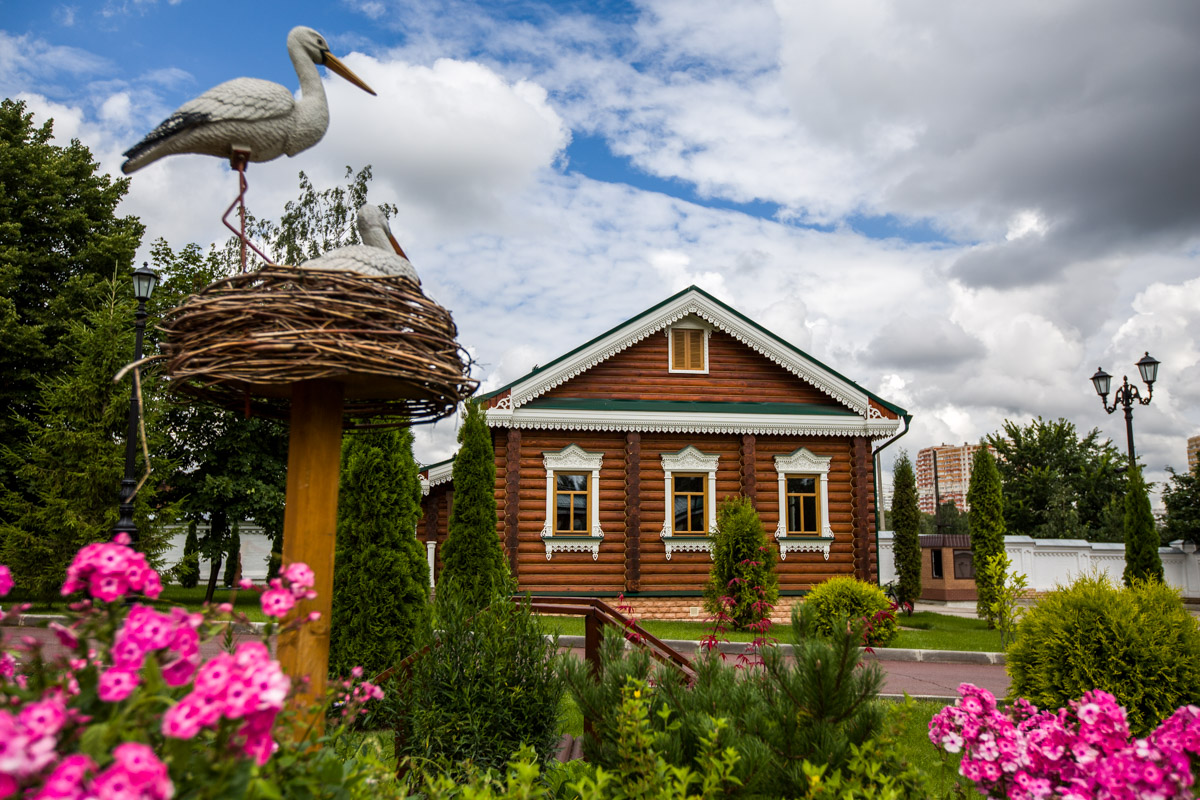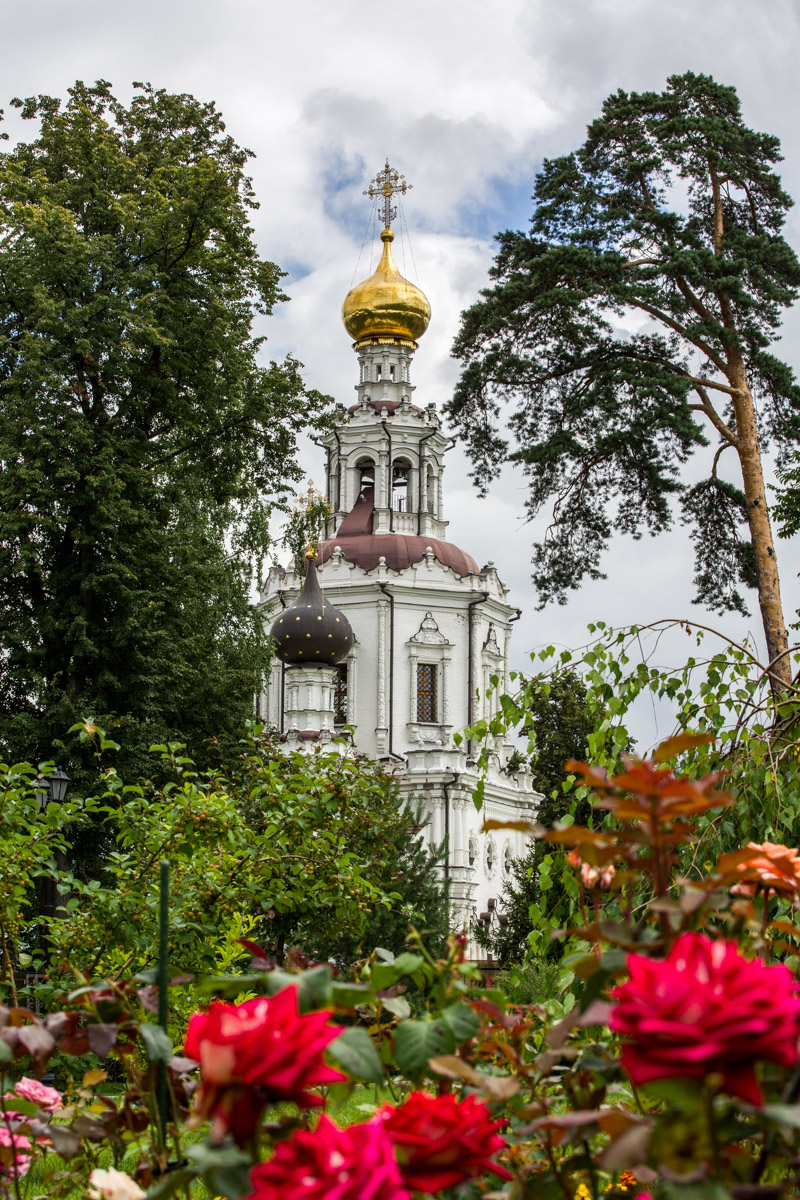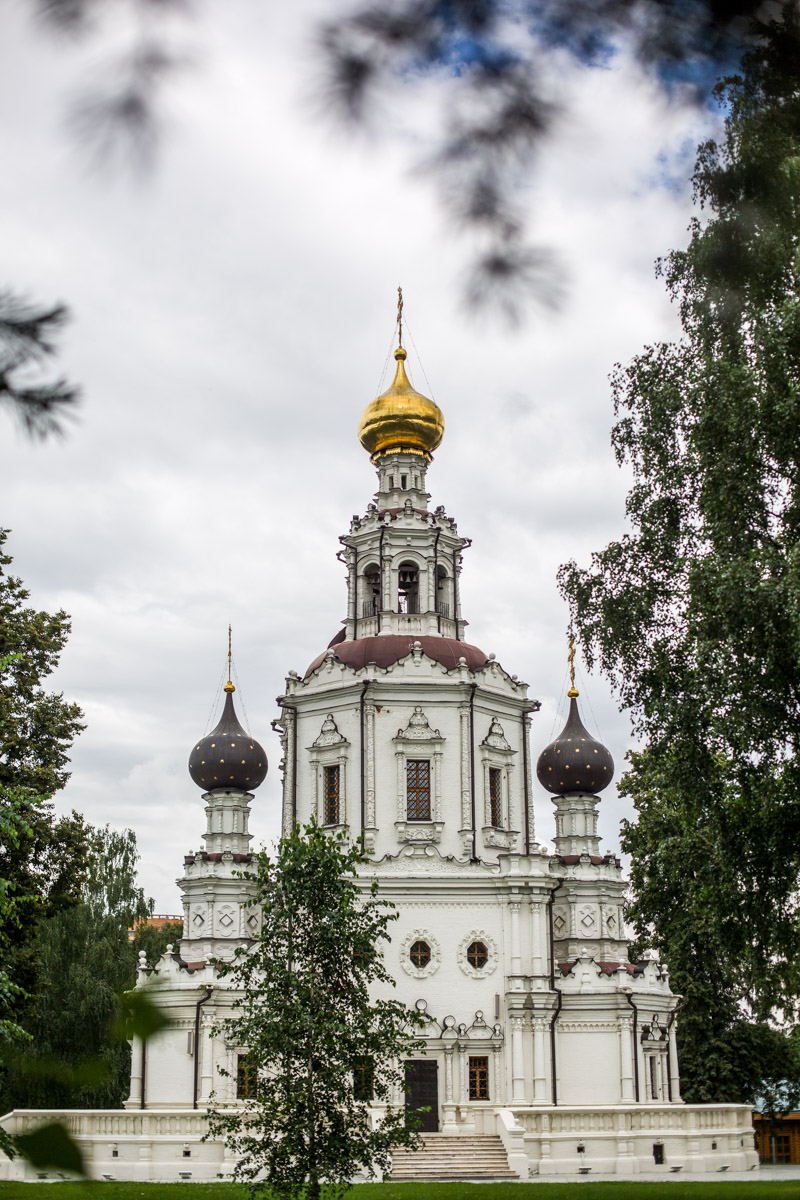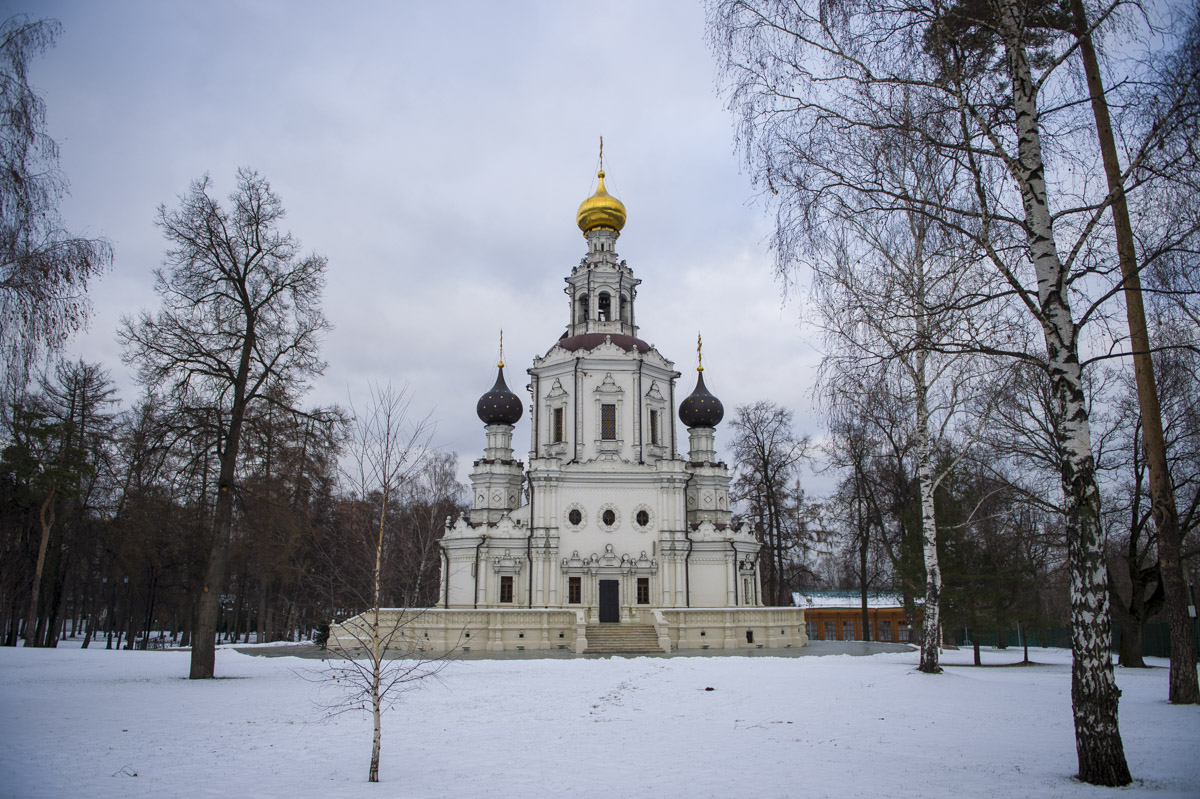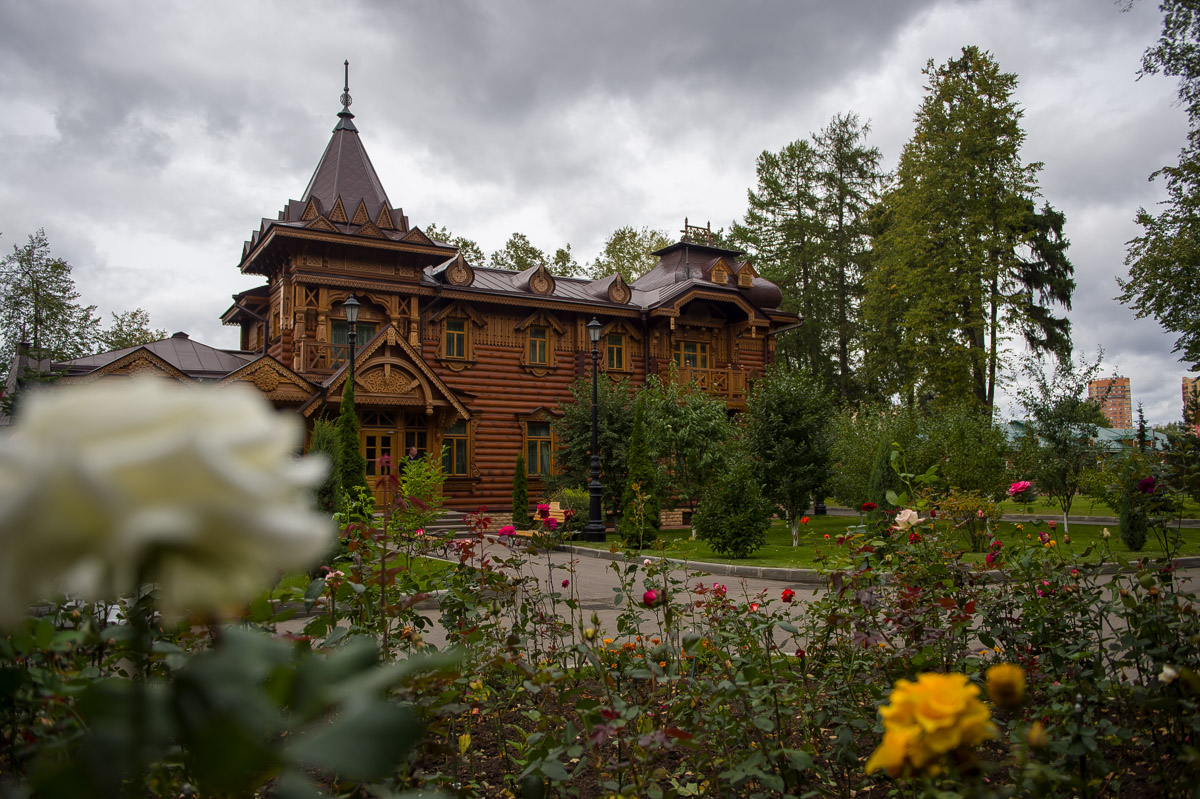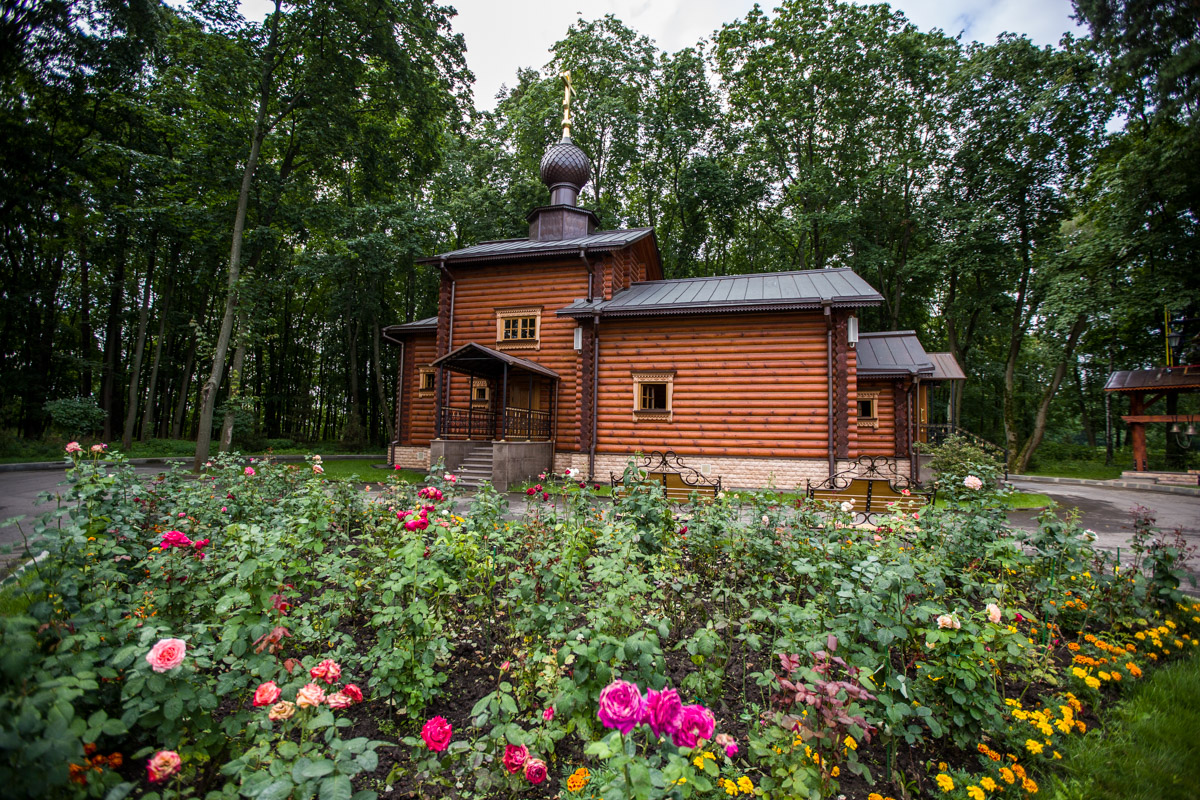The compound of the Intercession Сonvent in Troitse-Lykovo in Strogino district of Moscow
Troitse-Lykovo is located in the West of Moscow (Strogino district)
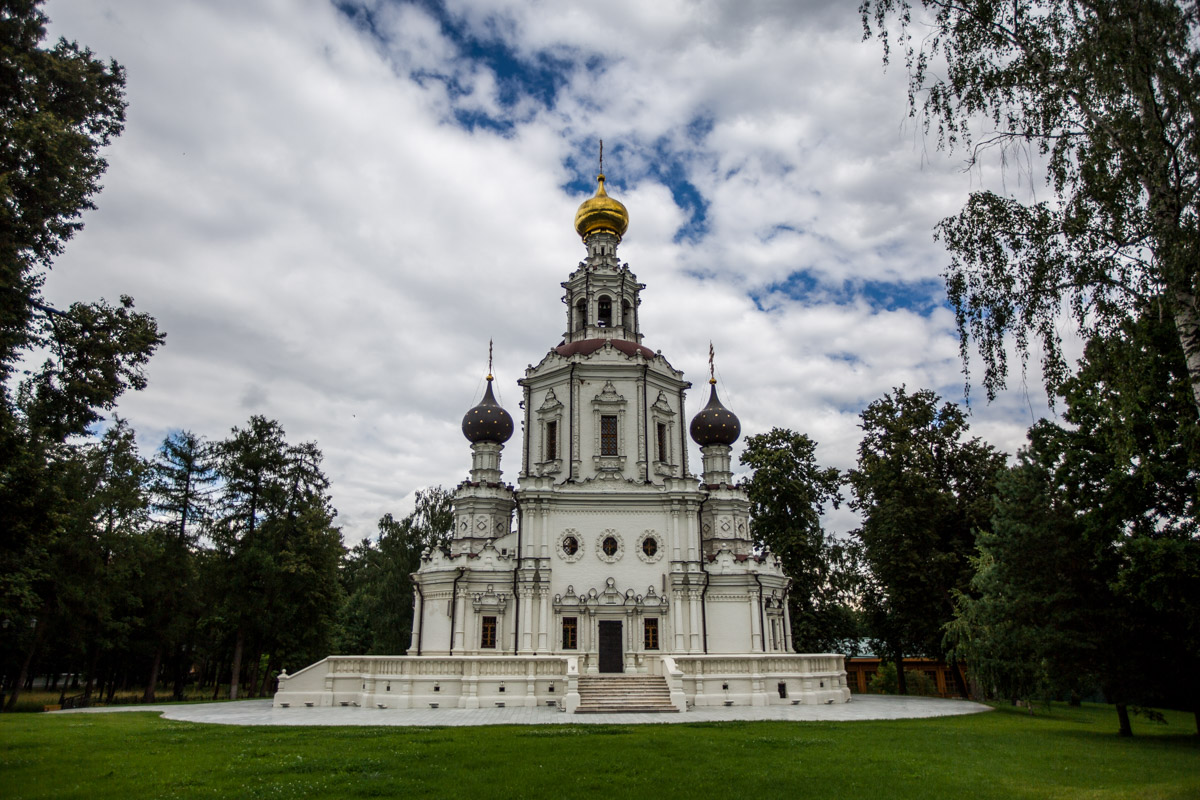
![]()
The first moleben in the church of the Assumption of the Blessed Virgin Mary in the Trinity-Lykovo of the Pokrovsky Stauropegial Convent. April 11, 2013
Troitse-Lykovo is located in the West of Moscow (Strogino district), on the right, high bank of the Moskva River. The history of Troitse – Lykovo and its temples is inextricably connected with the fate of the estate's owners, and reflects all the dramatic events of Russian history of XVI – XX centuries. Troitse – Lykovo has got its name after the Trinity Church and by the name of its first owner – Prince Lykov-Obolensky.
The village of Troitskoye (the ancient name of Troitse-Lykovo) is known from historical documents from the XVI century. Under the Tsar Vasily Shuisky, Troitskoye was granted for service to Prince Boris Mikhailovich Lykov-Obolensky. Boris Mikhailovich was a great-grandson of Prince Ivan Vladimirovich Obolensky, who was named "Lyko".
During the reign of tsars Vasily Shuisky and Mikhail Romanov, the prince had a prominent public and official position. In 1606, he was granted to the boyars. After the overthrow of Shuisky (during the interregnum), the Boyar Duma, consisting of seven boyars, including boyar Lykov, came to power.
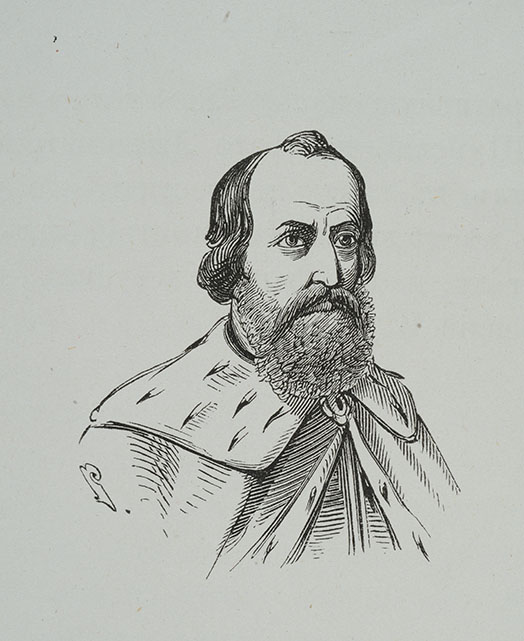
Vasily Shuiskiy (Russian Tsar 1606-1610)
In the Time of Troubles, he made many feats. In 1609 he distinguished himself in a victorious battle on Khodynskoye field. He did not let the poles to capture and burn Moscow. He contributed to the victory of the tsarist troops over the troops of False Dmitry II, and to the rebel army of Bolotnikov. He defeated the army of Hetman Lisowski and liberated the city of Kolomna captured by the poles. At the request of the Zemsky Council during the reign of Mikhail Romanov, he took an active part in the pacification of the country: defended Mozhaisk from the poles and fearlessly suppressed robbers who rampaged near Moscow.
He married Anastasia Nikitichna Romanova. She was relative of Queen Anastasia - the wife of Ivan the terrible, and sister of Patriarch Filaret. Therefore, the Prince was an uncle of Tsar Mikhail Fedorovich Romanov. This kinship put him in the forefront of the Moscow nobility. From 1619 to 1642 Lykov managed the most important state Orders. God-loving Prince built temples, helped monasteries. Boyar Lykov owned the land near lake Seliger and the island Stolbny, where in 1594 the monastery of Nilova Pustyn was founded, which was famous thanks to Reverend Nile Slobensky. Lykov believed that the Saint Nile Slobensky is his patron Saint, so Lykov fully supported the monastery.
Boris Mikhailovich Lykov faithfully served the Fatherland fifty years and died in 1646, he was buried in Saint-Pafnutevsky Borovsky monastery.
At the end of the XVII century, Troitskoe village passed into the possession of princes Naryshkin - Princess Natalia Kirillovna’s brothers (the mother of Tsar Peter I). Ivan Kirillovich Naryshkin, who married Princess Lykova, received, presumably, the estate as a dowry. In 1682, during the" Streletsky riot", he was captured by the rebels and got martyr death on the Red Square. In 1690 the village of Troitskoe was granted to another brother of the Queen, the steward of Tsar Peter I – Martemyan Kirillovich, and after his death, by a personal decree was passed into the possession of, perhaps, the most famous relative of the king – the boyar Lev Kirillovich Naryshkin, one of the most powerful and wealthy courtiers of that time, who headed the Ambassadorial order. He, in particular, owned the famous Tula factories and the village of Fili near Moscow, where he built the world-famous Church of the Intercession of Theotokos.
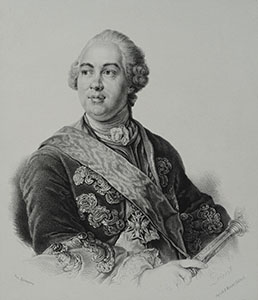
Count Kirill Grigorievich Razumovsky
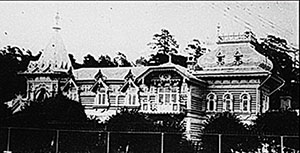
Manor house. Pre-revolutionary photo.
In 1749, Troitse-Lykovo passed to Kirill Grigorievich Razumovsky, who was married to the granddaughter of Lev Kirillovich - Ekaterina Ivanovna Naryshkina. Count Kirill Grigorievich was the President of the St. Petersburg Academy of Sciences, the field Marshal and the brilliant grandee at the court of two emperors: Elizabeth and Catherine II.
In the second half of the XIX century, the owner of the estate was count, major-General Nikolai Aleksandrovich Buturlin, the descendant of an ancient Russian noble family, rooted in the XIII century, which gave the country many famous military leaders, statesmen and diplomats. In 1876 the manor of Troitse-Lykovo passed to the merchant Ivan Ivanovich Karzinkin – hereditary honorable citizen, and after his death – to the son of Sergei Ivanovich, Tula nobleman, the head of the famous tea factory, who died in 1886, and was buried in the family chapel – the tomb at the Trinity Church estate. The last owner of Troitse-Lykovo – his widow Julia Matveevna Karzinkina.
By the end of the XIX century Troitse-Lykovo was a classic Russian manor - suburban "noble nest": a manor house in the Old Russian style with intricate carvings, the garden with flowerbeds, the park with a river, ponds, bridges, gazebos, statues and countless inventions.
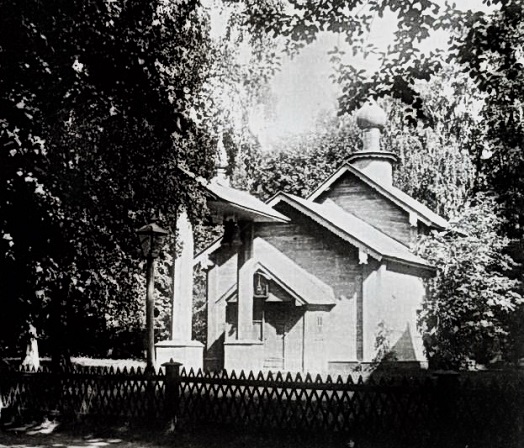
The wooden Church of the Dormition of the Virgin. Pre-revolutionary photo.
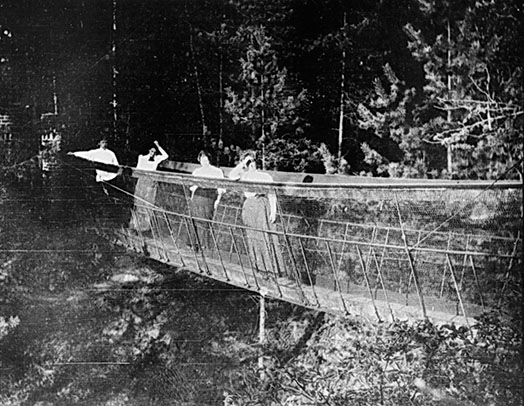
Suspension bridge over the moat in the Karzinkin manor. Photo of the late XIX century.
The central place was occupied by temples. At different times, several churches were built on the territory of Troitse-Lykovo manor. The first wooden Church in the name of the Holy Trinity (with chapels in honor of St. Nicholas and the martyrs Florus and Laurus) was built by Prince Lykov in his patrimonial village. Later it was destroyed and replaced by the stone one.
In the census books of 1698-1704, there is a record about wooden Church in honor of the Dormition of Theotokos, which Lev Kirillovich Naryshkin built. That Church was considered a rare monument of Russian wooden architecture of the XVII century, a large number of studies are written about it. It came to extreme dilapidation after two centuries. Having taken possession of the estate, the Karzinkins took all the measures to preserve the ancient temple - restored and updated it. The Dormition Church remained operating until it was burned down in 1936.

Trinity Temple in desolation, the second half of the XX century.
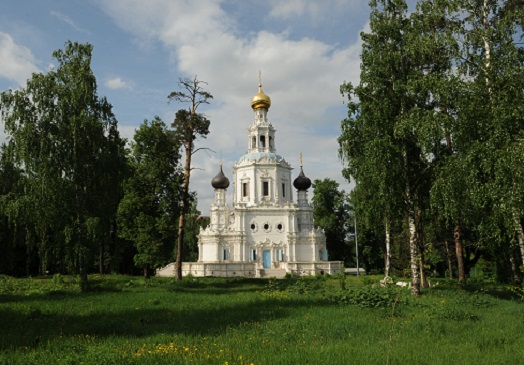
Trinity Temple, 2013
The main decoration of the park and the entire estate was the stone Church in the name of the Holy Trinity – the temple of amazing beauty of XVII century "under the bells" (the Church with the bell tower at the top).
According to the archival materials, the customer of the Trinity Church was Martemyan Kirillovich Naryshkin, and that its construction of the Church was completed in 1694. The temple was built in the style of "Moscow Baroque" (synthesis of Western Baroque and Old Russian national style), distinguished by the splendor of white-stone decoration and strict multi-tiered centric structure. Since many similar temples (of the Intercession in Fili, of Epiphany in Kitay-Gorod, of Boris and Gleb in Zyuzino) were built by order of the Naryshkins, this style is also called "Naryshkin Baroque". The builder of the Holy Trinity Church was Yakov Bukhvostov – a well-known architect of the XVII century. The architectural perfection of this temple, as well as its interior, attracted researchers, it was written about, it caused admiration.
The magnificent nine-tiered iconostasis impressed with its virtuoso gilded carvings made by the masters of the Armory. Outside, this snow-white Church with gilded openwork crosses was so beautiful that it was compared with the bride dressed in a lace outfit and a Golden kokoshnik, admiring its reflection in the waters of the Moskva River, so the temple was called "the White Swan". It was consecrated in 1708 under Peter I, and historians believe that the Tsar visited it, coming to Troitse- Lykovo to see his relatives.
The composition of the temple was a classic Baroque, tiered-pyramidal, or, in other words, "octagon on the quadrangle." The wide quadrangle is under the high wide octagon, and it has a narrower belfry, surmounted by a dome on a patterned drum. A semicircular symmetrical altar part and a Western porch with domes on two-tiered octagonal drums surround the sides of the temple. The temple is placed on a low basement – gulbische, surrounded by an elegant balustrade. As in all Baroque churches, the decoration of casings on high rectangular and small octagonal windows is remarkable: casings of all tiers are original and do not repeat.
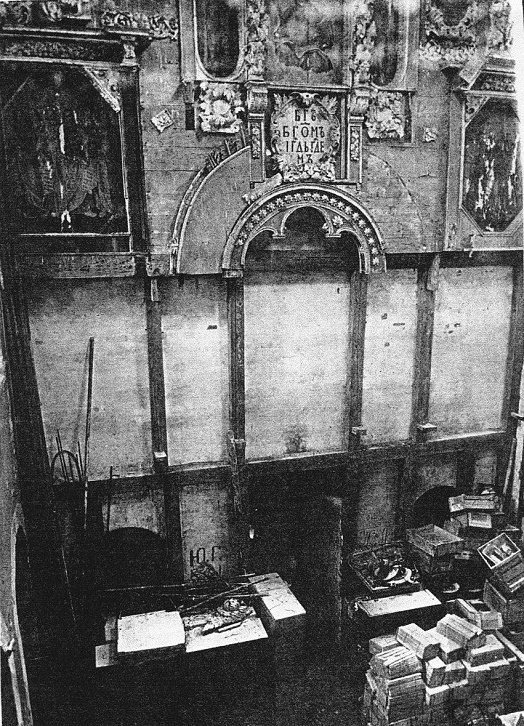 The Trinity Temple. The fragment of the iconostasis. 1982 |
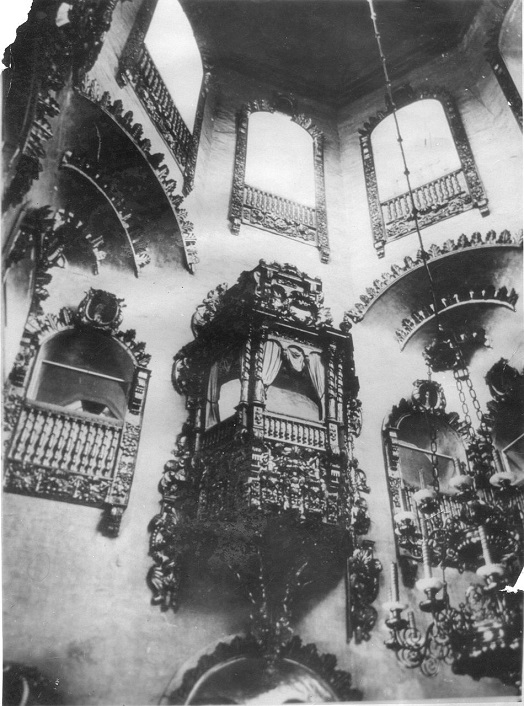 The Trinity Temple. The Tsar’s place. The end of the XIX century. |
The decoration of the interior was also luxurious. Before the destruction there was a carved nine-tier iconostasis, decorated in the Baroque style with vines and bunches of grapes and exotic fruits and plants. The Imperial place was in the Western part of the galleries. Originally, the interior walls were painted like marble. The galleries located along the walls in two layers; from the top one there was an access to the bell tower. Wrought iron doors and shutters were painted with floral ornaments, complementing the carved stonewall decorations.
1812 year brought the Trinity parish a lot of hardships and privations. 75 yards were burnt in the villages, and a two-months’ staying of the French soldiers completely ravaged the local inhabitants. The clergy of the Church suffered disasters and starvation.
The French took away from the temple a rich trophy. Among the stolen items was an old silver church chandelier, cut into pieces. The partisans fought off the loot. The Emperor Alexander I soon sent to the temple a new bronze chandelier with crystal pendants. The ancient antimins was also returned.
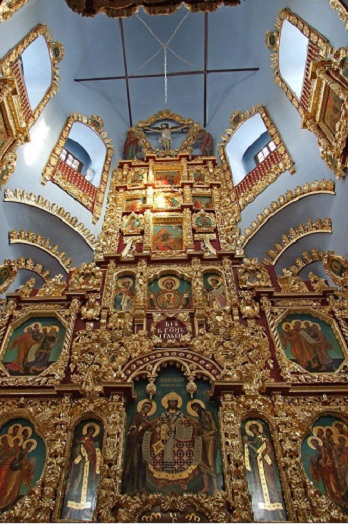 Iconostasis of the Trinity Temple Modern look |
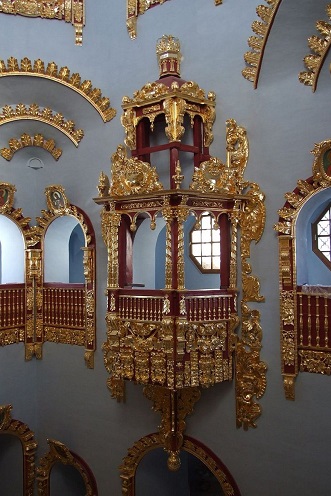 The Trinity Temple. The Imperial Place. 2013 year |
Three generations of the Karzinkins performed the duties of the Church elders: from 1876 to 1886 – Sergey Ivanovich, then to 1910 – Sergey Sergeevich, and till to the middle of 1920-ies – Ivan Sergeyevich. In 1879 the Karzinkins took up the repair of the temple: the iconostasis and central dome were re-gilded, paintings were renewed, the Church was whitewashed.
The Trinity Church was closed the second (after the Dormition Church) in 1933. In the Trinity Church, the authorities were going to open an exhibition of the national economy of the Turkmen SSR. For this purpose, it was planned to rebuild the building "in terms of withdrawal of heads, bas-reliefs, jewelry, decoration, reminiscent of the Church." Fortunately, the barbaric idea was not realized. In 1935, the temple of the Holy Trinity was declared an architectural monument of the world importance and taken into account by the League of Nations, later by the UNESCO Commission. Thus, it was saved from destruction.
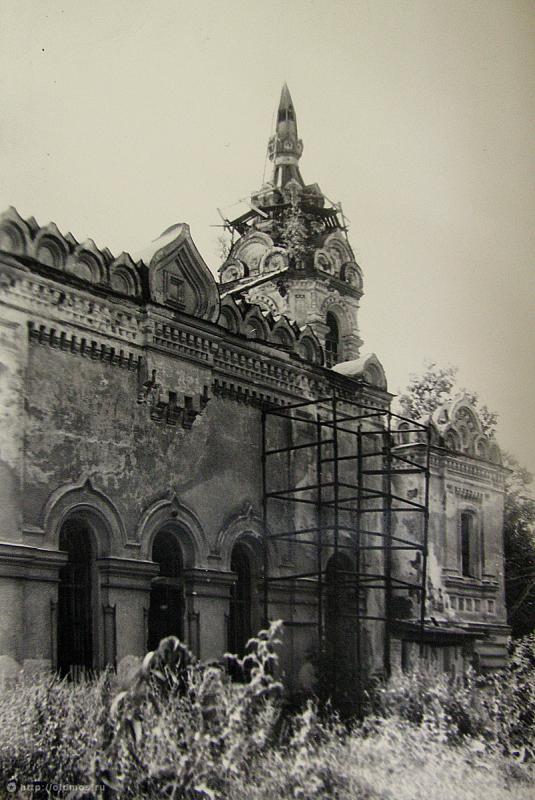 Dormition Temple, West view. 1980-ies. |
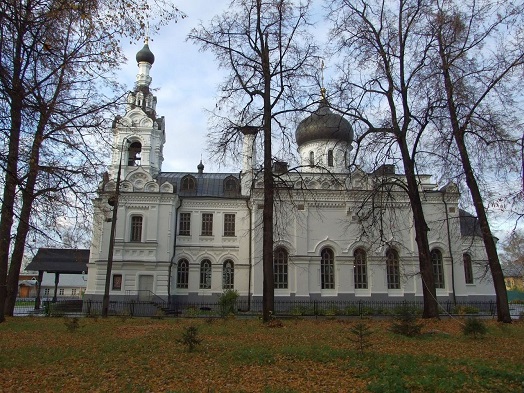 The Temple of Dormition of the Blessed Virgin. Modern look. |
In the winter of 1941, the Academy of architecture organized measurements and fixation of the best monuments of Russian architecture in Moscow region. There was a war nearby. Vasily Nikolaevich Podkluchnikov, the expert of "Naryshkin" Baroque, was sent to Lykovo, and brilliantly coped with the work. The result was a wonderful, well-illustrated album "Three monuments of the XVII century. The Church in Fili. The Church in Ubori. The Church of the Holy Trinity", was published in 1945, after the death of the author. These highly professional measurements later formed the basis for the restoration of the building. Closer to our time, a masterpiece of ancient architecture was completely unattended. The beautiful Church still causes an interest – thousands of lovers of antiquity visite it. However, by the early 1970s only pathetic fragments remained in the interior of the temple. The Ministry of culture still managed to give the minimum funds for its restoration. They supposed to open the branch of the State Museum of ancient Russian painting by Andrey Rublev.
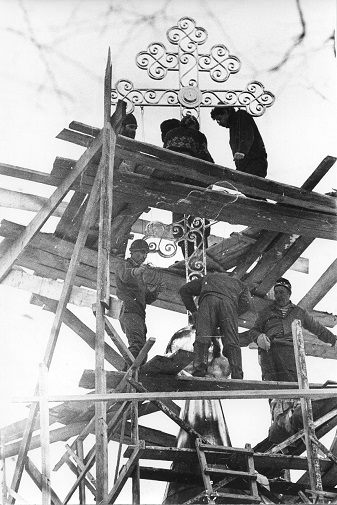 Installation of the cross at the Dormition Temple.20 February, 1993 |
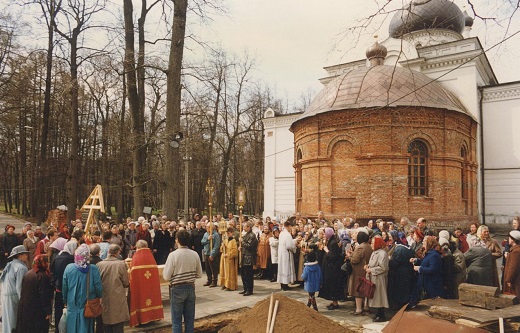 The establishment of the crosses in the Karzinkins burial place.1990-ies. |
For more than ten years, the architect of the all-Union scientific-restoration factory of the USSR Ministry of culture, an honored worker of culture Irina Valentinovna Ilyenko, a wonderful specialist in architecture of the late XVII century, worked here. The reconstruction of the lost elements of external decoration and wood carving in the interior began. However, the funding stopped, and the work was not finished. In the mid-1980s, the creation of a new Museum was out of the question, and the monument did not find the viewer.
 Rising of the bell. 27 April, 2013 |
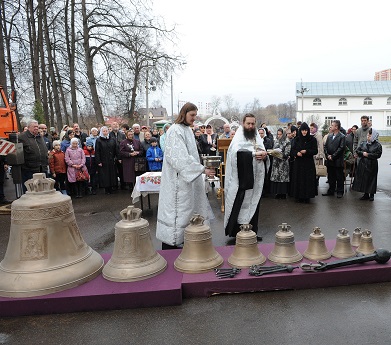 The consecration of the bells for the belfry of the Dormition Temple. 27 April 2013 |
N. A. Buturlin built the stone Church of the Dormition of the blessed Virgin Mary in Troitse-Lykovo in the second half of the XIX century. The Church had two chapels: St. Great Martyr Catherine and St. Nicholas the Wonderworker. The author of the project is unknown, but the architecture of the temple shows the influence of the «Russian-Byzantine" style. In 1851, the chapel of the Saint Martyr Catherine was consecrated.
Later Julia Matveevna Karzinkina restored and expanded the Church of the Dormition. Under the project of architect F. Kulagin, a refectory, a bell tower and a new chapel in honor of the Kazan icon of the mother of God were added. During the reconstruction, the iconostasis was gilded, icons were restored.
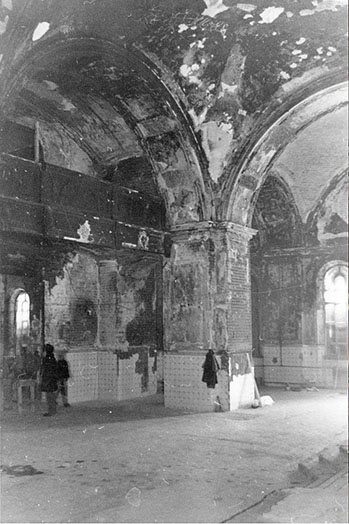 The Temple of the Dormition of the Blessed Theotokos. 1990. |
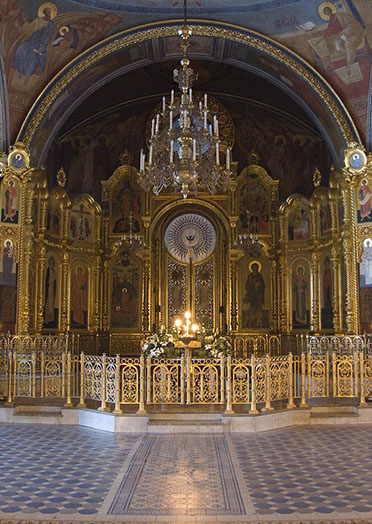 The Temple of the Dormition, the altar part. 2013 |
Pious owners of the estate built the temples and decorated them, and made contributions to the monasteries and various charitable institutions, helped the poor. Merchants Karzinkins in 1876 built the poorhouse, and in 1891, in Pine Park, opened the hospital for poor people. According to the spiritual will of Y. M. Karzinkina, the women community of Holy Trinity was established in February 1917, it dealt with matters of charity. According to the will, the entire estate, all lands and buildings belonged to the Holy monastery. The monastery did not last long.
The Karzinkins were the benefactors and lovers of art. Their house was always full of guests. The estate was frequently visited by the artists Apollinarius and Viktor Vasnetsov, collectors of paintings the Tretyakovs, the family of Chaliapin.
St. Seraphim of Sarov visited the temples of Troitse-Lykovo, while staying in the estate on the way to Sarov. His Holiness Patriarch Tikhon performed one of his last services here in the 1920s.
After the revolution of 1917 Troitse-Lykovo suffered the fate of thousands of Russian estates - Church and art values were taken away, crosses and bells were removed, and different institutions in the buildings of the estate and churches were placed. During the decades of the Soviet power, everything in Troitse-Lykovo was destroyed.
In 1923, the Estate was divided into parts and its existence ended. In 1924, the Soviet authorities removed a group of children from Turkmenistan and set up a Turkmen house of enlightenment and a boarding school. The former Karzinkins chapel was used as a lecture hall, a cinema and a club. Young citizens of Turkmenistan worked at the apiary, in the garden, in an Apple orchard – the boarding house economy was mostly natural.
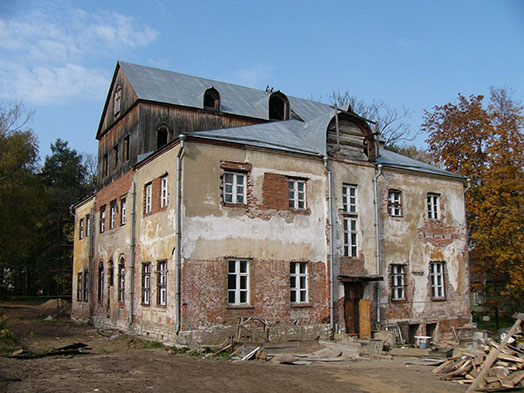
The former manor house. 2003.
In February 1929, the colony caught fire. The fire suspiciously appeared simultaneously in different places. The fire broke out. It was no longer possible to put it out with buckets. The firefighters did not arrive. Fortunately, no one died.
Thus ended one of the social experiments of the first years of Soviet power. Instead of the colony the usual kolkhoz was organized, which did not last long. Later Suvorov military school was located here.
Today, in the renovated manor house an Orthodox gymnasium is located.2013.
The ancient monument - a wooden Church – was burned down in 1936. It was a deliberate arson attack, and the perpetrator is well known. The Church was burned down by the head of the club, arranged in the stone Dormition Church, who was enraged by the absence of the people in his institution and a huge number of parishioners who barely fit in the temple.
The Church of the Dormition also had a hard fate. From 1943 to 1979 there was a rehearsal hall of Suvorov music school. At different times it was used as a reading room, a hospital, a club with a stage in the altar and even a canteen, and the last owner of the building was the Institute of atomic energy by Kurchatov. It arranged a warehouse of paints and varnishes in the church. In 1998 there was an explosion, that destroyed the remains of the ceiling painting. By some miracle, an amazing floor covered with carpet tiles remained untouched.
In October 1989, the half-destroyed Church of the Dormition in Troitse-Lykovo was returned to the Orthodox Church. It was surrounded by mountains of garbage, there were trees on the belltower, once beautiful Park came into complete disrepair, the necropolis and chapel-tomb were brutally destroyed, where the last owner of the estate of J. M. Karzinkina was buried.
On March 31, 1990, on the day of Praise of the most Holy Theotokos, the Church was consecrated again.
On October 25, 1999, on the eve of the feast of the Iver icon of the Mother of God, monks delivered the icon of the Mother of God "Iverskaya" to Troitse-Lykovo from Greece. Archimandrite Arseny wrote it for the Dormition Church.
Now the Dormition Church is restored: the bell tower has been erected, the dome and the roof have been recreated according to the old photos, the iconostasis, the kiots and the altar are restored, and the walls are decorated with beautiful icons. In front of the altar of the Church of the Dormition two graves were arranged, where the remains, found nearby, are buried. For a while, the abbot was Father Nikolai Tarasov, who was later sent to the Church of St. Nicholas in Rzhavki. In September 1990, Father Stefan Pristaya headed the parish in Troitse-Lykovo, earlier he served in the Temple of the icon of the Mother of God "Joy of all who sorrow" on Ordynka.
In April 2013, the temple complex was converted into a compound of the Intercession Convent.
On May 4, 2013, on a Great Saturday, his Holiness Patriarch Kirill of Moscow and all Russia visited the Church of the Dormition of the Theotokos in Troitse-Lykovo. In his speech, his Holiness Patriarch Kirill said that the Church received the status of the compound of the Intercession Convent, so that, according to his Holiness, the spiritual life of the parishioners "was carried out here through the prayers of the Holy righteous Matrona of Moscow, the great Wonderworker." "I believe that this place will flourish and the Church and religious life will be strengthened," added the Primate, » and there will be even more children and young people, people of all ages, because many people live nearby. It is important for this temple to become the center of spiritual life."
The Holy Patriarch blessed abbess Theophany to restore the metochion and congratulated everyone with the upcoming holiday of Easter.
The Primate of the Russian Church blessed the clergy, parishioners and inhabitants of Strogino in the North-West of Moscow. He urged them to keep the faith in their hearts and do everything.
Many people who live in a huge cite forget about God, he asked them to entrust their lives to the commandments of God. "If this happens, then all the troubles that prevent people from living - crime, corruption, injustice, and many other things that place a heavy burden on the conscience and on the lives of people-will go away; with faith in God and Christ, who saved the world from evil, we can really transform our personal, family, and social life," - his Holiness said in conclusion.
Galleria

























































